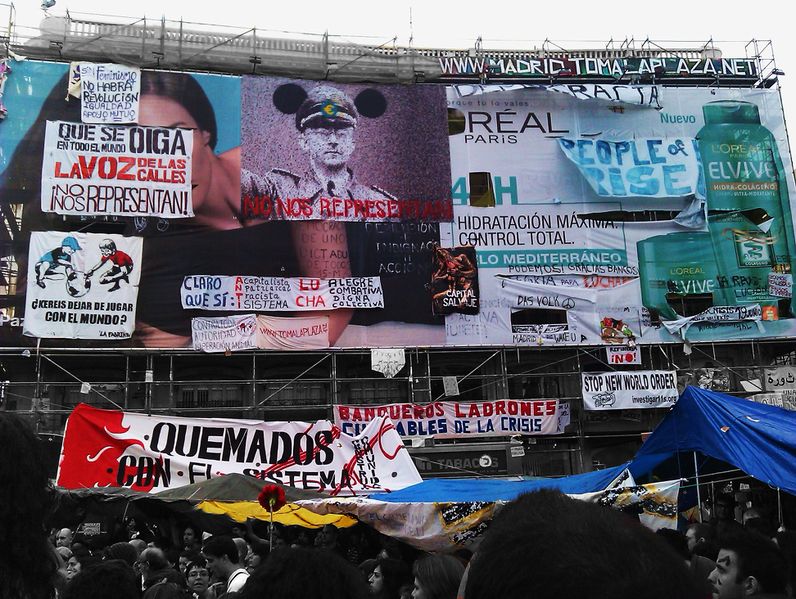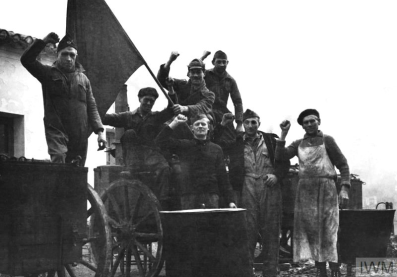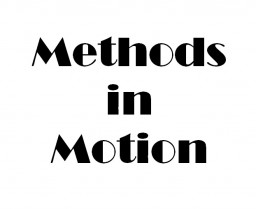
Communication, and the discursive formation of public opinion in the public sphere, is a key component of liberal democratic politics. A dilemma, therefore, is how these tools, which secure liberal democracy, can also be used to challenge it. This has been an aspect of my research into the 15M movement in Spain, and their attempts to change people’s perceptions of what is politically and economically possible. Prompted by Paul-Francois Tremlett’s recent blog on physical protest objects, I would like to contribute my reflections on using language and discourse to imagine a politics beyond liberal rationalism.
The 15M, which began in May 2011, was a protest against the economic crisis, the austerity measures imposed by the then Socialist Government, the staggeringly high rate of youth unemployment, and an unresponsive political system. The mass occupation of public squares across Spain attested to the revitalisation of the public sphere as a space where citizens come together to formulate and articulate ideas. Email communications sent to me by participants, newspaper accounts and online blogs described how, during the occupation of the main Sol square in Madrid, different committees first met at 1 p.m. before a general assembly and public protest at 8 p.m. every evening. People gathered to hear the assembly opinions and news, with subsequent decisions made by majority. Everyone had the right to speak and to vote but not to veto. The movement placed great emphasis on getting its message across: it is no coincidence that, of the eight committees originally organised, three concerned communication.
This physical occupation of public squares was matched by the emergence of a digital and critical public sphere in which the 15M’s ideas emerged and circulated. Under the main portal of www.madrid.tomalaplaza.net lies a virtual public sphere composed of numerous websites, blogs, twitter accounts, the 15Mpedia, Facebook communities, Internet radio stations like Agora Sol Radio and YouTube channels such as Spanishrevolutionsol.
Yet how do we measure the significance and impact of the 15M for politics in Spain? For many participants, the so-called “Indignados” [the outraged], the issue is not how successful the 15M has been in changing particular policies but how successful it has been in challenging the prevailing ‘common-sense’. That is, how far they have destabilised the hegemonic neo-liberal discourse which has dominated Spanish politics since the transition to democracy in the 1970s.
One way of analysing how hegemonic discourse has been destabilised is to examine the extent to which new language and new discourses have permeated everyday discourse. Language is crucial to the ways in which hegemony is both secured and contested. The 15M focused significant effort on communicating new ways of talking about and imagining politics. The power of the 15M slogans ‘They don’t represent us’ and ‘Our dreams don’t fit in your ballot boxes’ lies in their challenge to the hegemonic culture in which politicians respond more effectively to the imperatives of the global financial markets than they do to voters’ demands. The widespread use of the acronym ‘PPSOE’ did much to portray the two main parties (PSOE and PP) as a single corrupt political elite. Another new term - ‘la casta’ [the caste] – referred to, and so amplified the idea that, various supposedly separate political and economic elites, such as politicians, bankers, judges, journalists (etc.) - were all part of the same regime established after Franco who have shifted power back and forth between themselves*. The economic crisis was portrayed not as a crisis but as a ‘scam’ or ‘swindle’ [estafa] perpetuated by concrete individuals rather than impersonal market forces, while deaths resulting from the wider economic crisis and its related austerity measures were labelled ‘austericidio’ [austericide] or ‘genocidio financiero’ – financial genocide.
For researchers, the dual physical and online presence of the 15M poses a particular methodological and analytic challenge. It is difficult to answer questions around how we can understand the relationship between online and offline spheres, and how we as researchers can ‘be there’ digitally to conduct participant observation. Measurement is also tricky: how do we know what impact new language and discourse has? Mixed methods offer some solutions: traditional opinion polls can indicate the extent to which citizens are familiar, and have sympathy with, a social movement’s ideas. Sociological content analysis can be used to examine the media ecology of tweets, photos, videos and other website content. The extent to which a social movement’s ideas and language gain traction can be measured by examining how ideas from the 15M social media capture the attention of traditional newspapers. Such methods go some way to exploring the impact of a social movement, by building understanding of the relationship between its virtual and physical presence.
Footnote: Contemporary use of “La Casta” is a rhetorical reference to the 18th century Spanish Empire’s system of racial classification, in which the “white” elite were separated from other groups and given access to economic privileges and opportunities that were unavailable to the majority of the population. In its current usage, use of the term has no racial connotations but denotes ‘the establishment’ who have monopolised power in Spain since the transition to democracy in the 1970s.
The Methods in Motion blogs are by researchers linked to the Centre for Citizenship, Identities and Governance. The blogs represent their opinions emerging from research in progress, and do not necessarily represent the views of the Research Centre or Open University. You can discover more about Methods in Motion on the CCIG website.






Rate and Review
Rate this article
Review this article
Log into OpenLearn to leave reviews and join in the conversation.
Article reviews